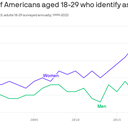Political gender gap grows as young women move left

Young women who increasingly identify as liberal are driving a stark political gender gap with their male counterparts.
Why it matters: Men affected by many of the same societal forces — early exposure to smartphones and social media and a toxic political culture — aren't budging.
By the numbers: Women aged 18 to 29 are now 15 percentage points more likely to identify as liberal than men in the same group, according to Gallup data. That gap is five times larger than it was in 2000.
- More young women also now identify as liberal (40%) than moderate (37%).
- Young men are slightly more likely to identify as conservative (29%) than liberal (25%), with moderate (44%) as the largest share — numbers which have remained remarkably steady over the last 25 years.
Zoom in: The gender gap first passed 10 points in 2017, when former President Trump took office.
- The #MeToo movement took off the same year, potentially pushing a younger generation of women to the left as they entered adulthood.
- Abortion rights also became a more pressing issue after Roe v. Wade was overturned in 2022.
- Women aged 18-29 were 13 points more likely to identify as "pro-choice" than men, according to a Harvard poll released last year.
Between the lines: The oldest subset of women — 65 and up — is also moving to the left. That's mostly a factor of liberal Baby Boomers getting older, said Lydia Saad, director of U.S. social research at Gallup.
- "But these young women [aged] 18 to 29 are starting off their adult life much more liberal," Saad said.
Zoom out: Gender polarization could have far-reaching consequences as politics becomes a bigger part of American life.
- Fewer young people are willing to be friends or date someone who doesn't share their politics.
- In a 2021 poll, 71% of Democratic college students said they wouldn't go on a date with someone who voted for the opposing presidential candidate.
The big picture: Ideological gender gaps have simultaneously developed in a stunning number of countries around the world, the Financial Times reports.
- The trend in most countries mirrors the United States: "One of women shifting left while men stand still."